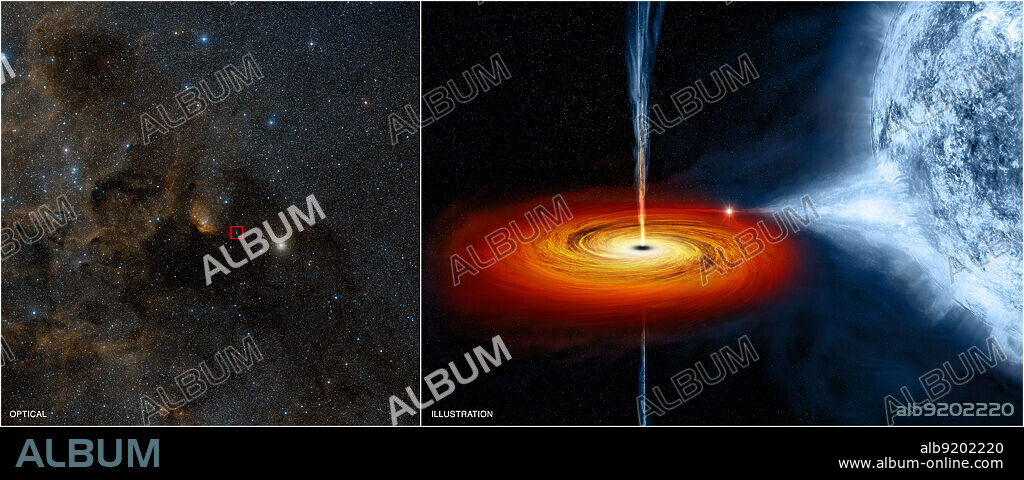alb9202220
Cygnus X-1, Stellar-Mass Black Hole

|
Ajouter à une autre Lightbox |
|
Ajouter à une autre Lightbox |



Avez-vous déjà un compte? S'identifier
Vous n'avez pas de compte ? S'inscrire
Acheter cette image.
Sélectionnez l'usage:

Titre:
Cygnus X-1, Stellar-Mass Black Hole
Légende:
Voir la traduction automatique
On the left, an optical image from the Digitized Sky Survey shows Cygnus X-1, outlined in a red box. Cygnus X-1 is located near large active regions of star formation in the Milky Way, as seen in this image that spans some 700 light years across. An artist's illustration on the right depicts what astronomers think is happening within the Cygnus X-1 system. Cygnus X-1 is a so-called stellar-mass black hole, a class of black holes that comes from the collapse of a massive star. The black hole pulls material from a massive, blue companion star toward it. This material forms a disk (shown in red and orange) that rotates around the black hole before falling into it or being redirected away from the black hole in the form of powerful jets. A trio of papers with data from radio, optical and X-ray telescopes, including NASA's Chandra X-ray Observatory, has revealed new details about the birth of this famous black hole that took place millions of years ago. Using X-ray data from Chandra, the Rossi X-ray Timing Explorer, and the Advanced Satellite for Cosmology and Astrophysics, scientists were able to determine the spin of Cygnus X-1 with unprecedented accuracy, showing that the black hole is spinning at very close to its maximum rate. Its event horizon, the point of no return for material falling towards a black hole, is spinning around more than 800 times a second. Release date November 17, 2011.
Personnalités:
Crédit:
Album / NASA/CXC/M.Weiss / Science Source
Autorisations:
Modèle: Non - Propriété: Non
Questions sur les droits?
Questions sur les droits?
Taille de l'image:
Pas disponible
Taille d'impression:
Pas disponible
Mots clés:
21E SIECLE • ARTISTE • ARTISTEL • ARTSTE • ASTRONOMIE • CIEL • COSMOLOGIE • COSMOS • DIAGRAMME • ÉVÉNEMENT • EVOLUTION • ILLUSTRATION • MASS • POINT • SCIENCE: ASTRONOMIE • XXIE SIECLE
 Pinterest
Pinterest Twitter
Twitter Facebook
Facebook Copier le lien
Copier le lien Email
Email
